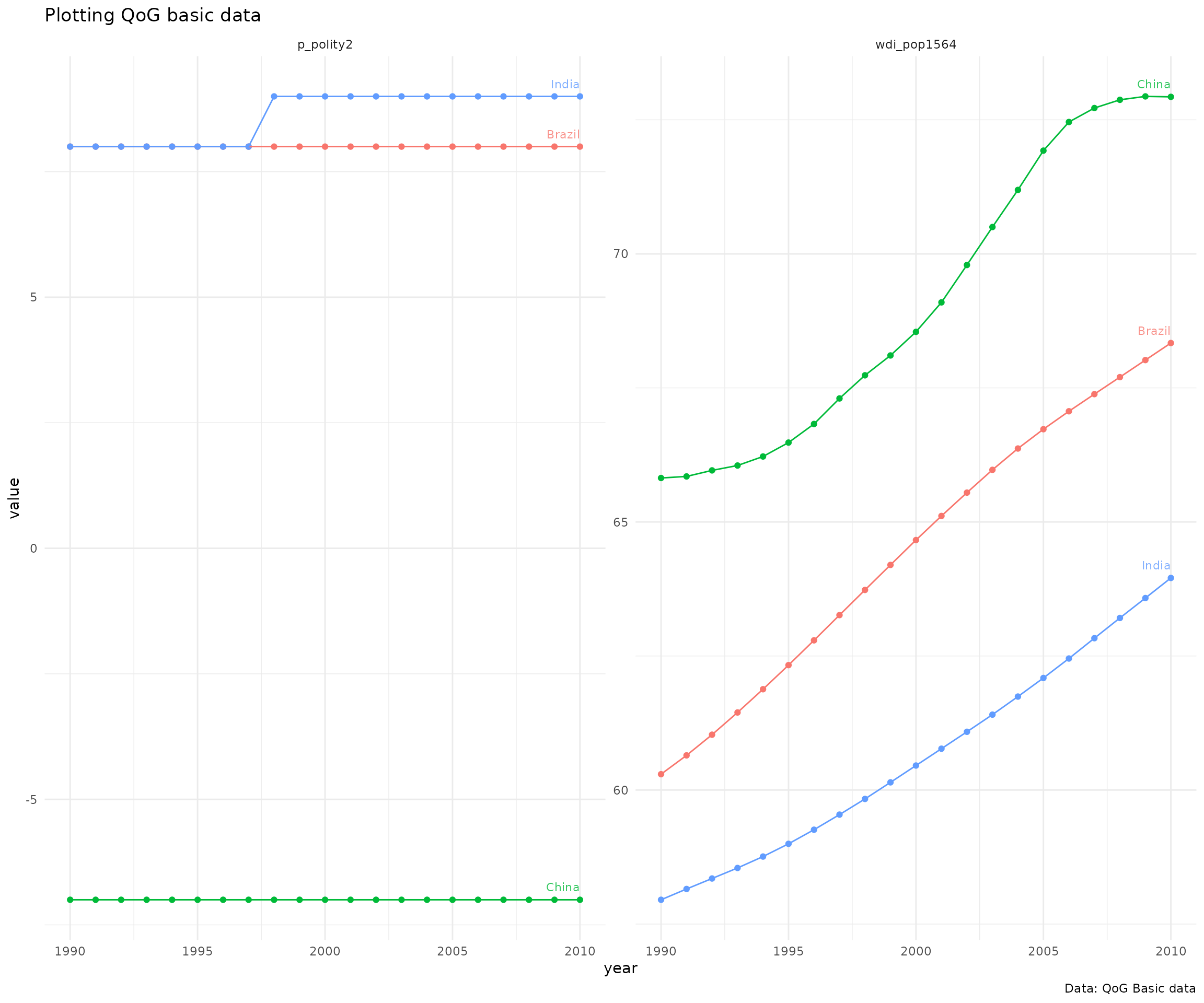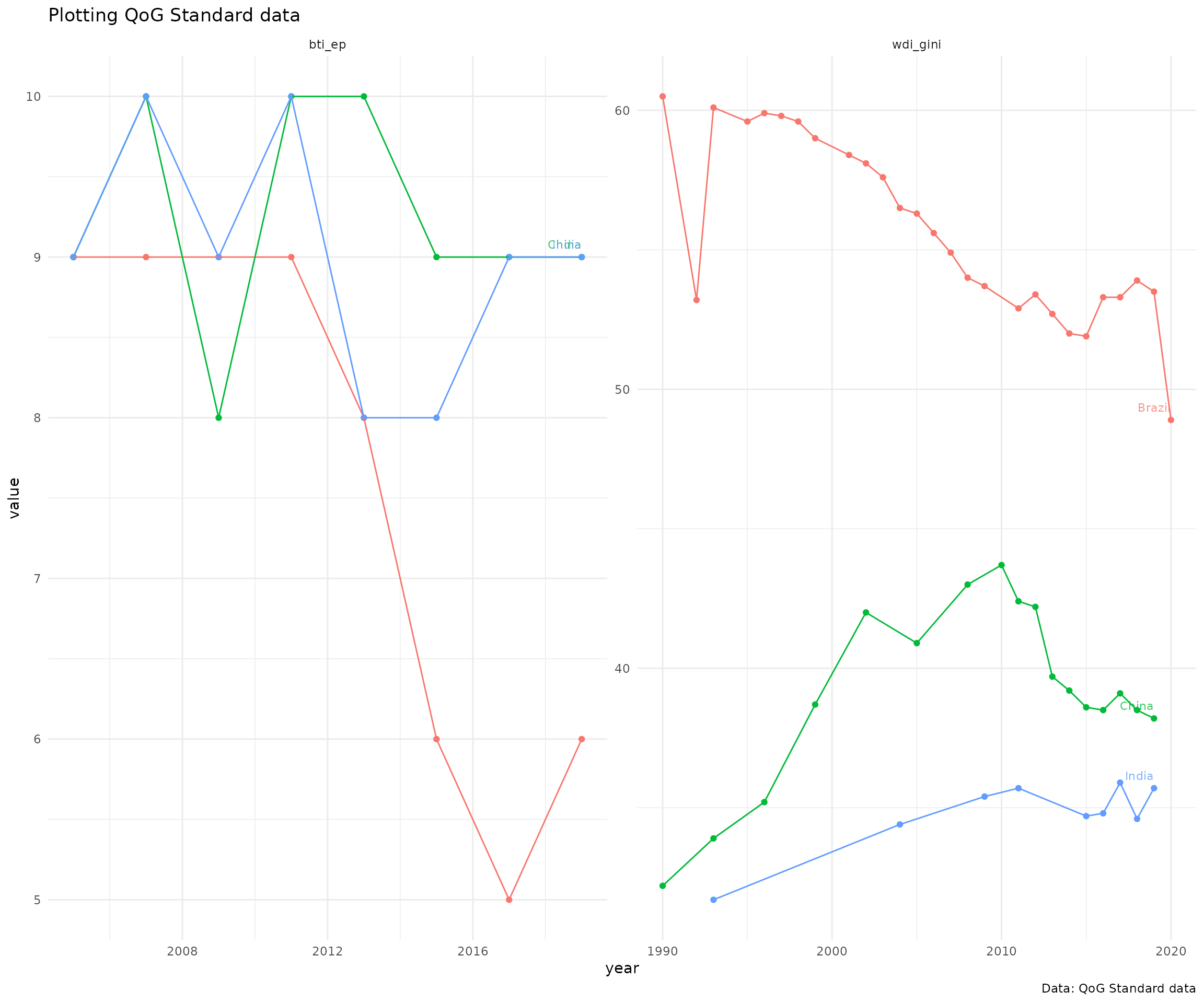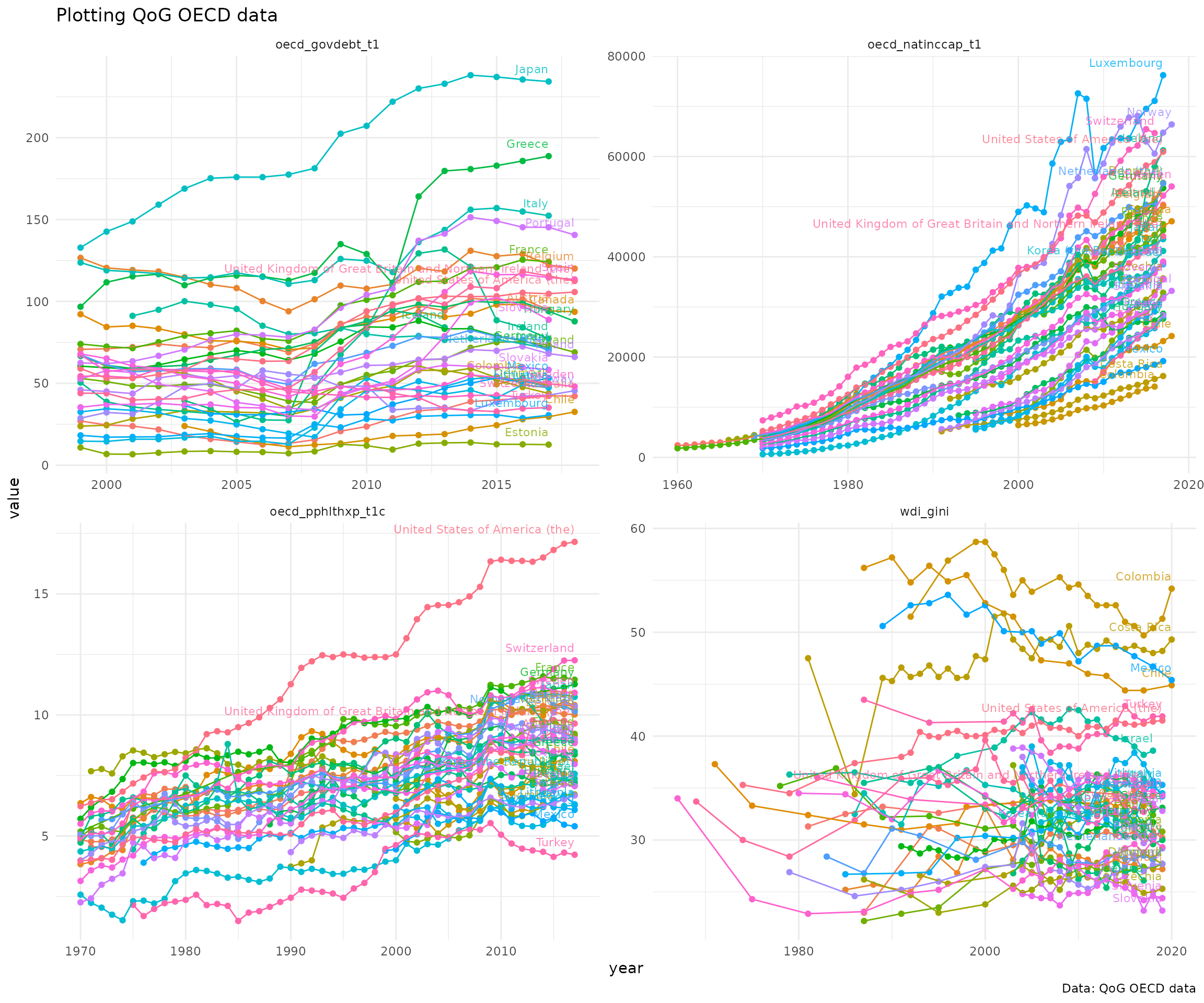compiled at 2023-04-17 11:54:50
Download data from the Quality of Government Institute data
Quotation from Quality of Governance institute website
The QoG Institute was founded in 2004 by Professor Bo Rothstein and Professor Sören Holmberg. It is an independent research institute within the Department of Political Science at the University of Gothenburg. We conduct and promote research on the causes, consequences and nature of Good Governance and the Quality of Government (QoG) - that is, trustworthy, reliable, impartial, uncorrupted and competent government institutions.
The main objective of our research is to address the theoretical and empirical problem of how political institutions of high quality can be created and maintained. A second objective is to study the effects of Quality of Government on a number of policy areas, such as health, the environment, social policy, and poverty. We approach these problems from a variety of different theoretical and methodological angles.
Quality of Government institute provides data in five different data sets, both in cross-sectional and longitudinal versions:
rqog-package provides access to
Basic, Standard and
OECD datasets through function read_qog().
Standard data has all the same indicators as in
Basic data (367 variables) and an additional ~1600
indicators. Both basic and standard
datasets have 194 countries. OECD dataset has 1020
indicators from 35 countries. rqog uses
longitudinal datasets by default that have time-series of
varying duration from majority of the indicators and countries.
Quality of Government Institute provides codebooks for all datasets:
You consult the codebooks for description of the data and indicators.
Installation
library(devtools)
install_github("ropengov/rqog")
library(rqog)Examples
Download data and plot numeric indicators
Basic Data
Basic data has a selection of most common indicators, 344 indicators from 211 countries. Below is an example on how to extract data on population and Democracy (Freedom House/Polity) index from BRIC-countries from 1990 to 2010 and to plot it.
library(rqog)
library(dplyr)
library(ggplot2)
library(tidyr)
# Download a local coppy of the file
basic <- read_qog(which_data="basic", data_type = "time-series")
# Subset the data
dat.l <- basic %>%
# filter years and countries
filter(year %in% 1990:2010,
cname %in% c("Russia","China","India","Brazil")) %>%
# select variables
select(cname,year,p_polity2,wdi_pop1564) %>%
# gather to long format
gather(., var, value, 3:4) %>%
# remove NA values
filter(!is.na(value))
# Plot
ggplot(dat.l, aes(x=year,y=value,color=cname)) +
geom_point() + geom_line() +
geom_text(data = dat.l %>%
group_by(cname) %>%
filter(year == max(year)),
aes(x=year,y=value,label=cname),
hjust=1,vjust=-1,size=3,alpha=.8) +
facet_wrap(~var, scales="free") +
theme_minimal() +
theme(legend.position = "none") +
labs(title = "Plotting QoG basic data",
caption = "Data: QoG Basic data")
Standard data
Standard data includes 2190 indicators from 211 countries. Below is an example on how to extract data on Economic Performance and GINI index (World Bank estimate) from BRIC-countries and plot it.
library(rqog)
# Download a local coppy of the file
standard <- read_qog("standard", "time-series")
# Subset the data
dat.l <- standard %>%
# filter years and countries
filter(year %in% 1990:2020,
cname %in% c("Russia","China","India","Brazil")) %>%
# select variables
select(cname,year,bti_ep,wdi_gini) %>%
# gather to long format
gather(., var, value, 3:4) %>%
# remove NA values
filter(!is.na(value))
# Plot the data
# Plot
ggplot(dat.l, aes(x=year,y=value,color=cname)) +
geom_point() + geom_line() +
geom_text(data = dat.l %>%
group_by(cname) %>%
filter(year == max(year)),
aes(x=year,y=value,label=cname),
hjust=1,vjust=-1,size=3,alpha=.8) +
facet_wrap(~var, scales="free") +
theme_minimal() +
theme(legend.position = "none") +
labs(title = "Plotting QoG Standard data",
caption = "Data: QoG Standard data")
OECD data
OECD data includes 1006 variables, but from a smaller number of wealthier countries of 36. In the example below four indicators:
- Total expenditure on health
oecd_pphlthxp_t1c - Income inequality: GINI index (World Bank estimate)
wdi_gini - Gross National Income per Capita
oecd_natinccap_t1 - Adjusted general government debt-to-GDP (excl. unfunded pension
liability)
oecd_govdebt_t1
We will include all the countries and all the years included in the data.
library(rqog)
# Download a local coppy of the file
oecd <- read_qog("oecd", "time-series")
# Subset the data
dat.l <- oecd %>%
# select variables
select(cname,year,oecd_pphlthxp_t1c,wdi_gini,oecd_natinccap_t1,oecd_govdebt_t1) %>%
# gather to long format
gather(., var, value, 3:6) %>%
# remove NA values
filter(!is.na(value))
# Plot the data
# Plot
ggplot(dat.l, aes(x=year,y=value,color=cname)) +
geom_point() + geom_line() +
geom_text(data = dat.l %>%
group_by(var,cname) %>%
filter(year == max(year)),
aes(x=year,y=value,label=cname),
hjust=1,vjust=-1,size=3,alpha=.8) +
facet_wrap(~var, scales="free") +
theme_minimal() +
theme(legend.position = "none") +
labs(title = "Plotting QoG OECD data",
caption = "Data: QoG OECD data")
Work with metadata and factor indicators
Packages is shipped with seven metadatas for each year (2016-2022)
meta_basic_cs_2022, meta_basic_ts_2022,
meta_std_cs_2022, meta_std_ts_2022,
meta_oecd_cs_2022 and meta_oecd_ts_2022. Data
frames are generated from original spss versions of data
using tidymetadata::create_metadata()-function.
Browsing metadata
You can browse the content by applying grepl to
name column. Let’s find indicators containing term
Corruption either in lower or uppercase.
## # A tibble: 10 × 5
## code name value label class
## <chr> <chr> <dbl> <chr> <chr>
## 1 bci_bci The Bayesian Corruption Indicator NA NA nume…
## 2 ccp_cc Corruption Commission Present in Constitution 1 1. Y… fact…
## 3 ccp_cc Corruption Commission Present in Constitution 2 2. No fact…
## 4 ccp_cc Corruption Commission Present in Constitution 90 90. … fact…
## 5 ccp_cc Corruption Commission Present in Constitution 96 96. … fact…
## 6 ccp_cc Corruption Commission Present in Constitution 97 97. … fact…
## 7 ti_cpi Corruption Perceptions Index NA NA nume…
## 8 vdem_corr Political corruption index NA NA nume…
## 9 wbgi_cce Control of Corruption, Estimate NA NA nume…
## 10 wdi_tacpsr CPIA transparency-accountability-corruption in … NA NA nume…Assigning labels to values with metadata
The data rqoq imports to R is in
.csv-format without the labels and names shipped together
with spss or Stata formats. As such it is the
desired format to work with in R, especially with numeric indicators.
However, many of the indicators in QoG are factors meaning that they
have discrete values with a corresponding label. You can use the
metadatas to assign labels for values of such indicators. Lets take the
ccp_cc as an example below and first print the
value and label colums of the data.
## # A tibble: 5 × 2
## value label
## <dbl> <chr>
## 1 1 1. Yes
## 2 2 2. No
## 3 90 90. left explicitly to non-constitution
## 4 96 96. Other
## 5 97 97. Unable to determineCurrently we have basic data in R in an object called
basic. Lets see the frequencies of each value
## ccp_cc n
## 1 1 527
## 2 2 8999
## 3 96 253
## 4 NA 5587Now, using the metadata with assign values with corresponding labels
basic %>%
count(ccp_cc) %>%
mutate(ccp_cc_lab = meta_basic_ts_2022[meta_basic_ts_2022$code == "ccp_cc",]$label[match(ccp_cc,meta_basic_ts_2022[meta_basic_ts_2022$code == "ccp_cc",]$value)])## ccp_cc n ccp_cc_lab
## 1 1 527 1. Yes
## 2 2 8999 2. No
## 3 96 253 96. Other
## 4 NA 5587 <NA>So, lets find two factor variables with few more values from the cross-sectional data
meta_basic_cs_2022 %>%
filter(class =="factor") %>%
group_by(code) %>%
summarise(n_of_values = n()) %>%
arrange(desc(n_of_values))## # A tibble: 20 × 2
## code n_of_values
## <chr> <int>
## 1 gol_pr 28
## 2 gol_est_spec 12
## 3 ht_colonial 11
## 4 ht_region 10
## 5 cpds_tg 7
## 6 ccp_slave 6
## 7 ccp_cc 5
## 8 ccp_childwrk 5
## 9 ccp_equal 5
## 10 ccp_freerel 5
## 11 gd_ptsa 5
## 12 gd_ptsh 5
## 13 lp_legor 5
## 14 ccp_strike 4
## 15 fhn_fotnst 3
## 16 gol_est 3
## 17 nelda_mbbe 3
## 18 nelda_mtop 3
## 19 nelda_oa 3
## 20 nelda_rpae 3Lets take these two factors and summarise the regime types per regions
meta_basic_cs_2022 %>%
filter(code %in% c("ht_region","ht_colonial")) %>%
distinct(code, .keep_all = TRUE)## # A tibble: 2 × 5
## code name value label class
## <chr> <chr> <dbl> <chr> <chr>
## 1 ht_colonial Colonial Origin 0 0. Never colonized by a Wes… fact…
## 2 ht_region The Region of the Country 1 1. Eastern Europe and post … fact…
# lets download the cross-sectional data first
basic_cs <- read_qog(which_data = "basic", data_type = "cross-sectional")
plot_d <- basic_cs %>%
# group by region
group_by(ht_region) %>%
# count per group frequencies of each regime type
count(ht_colonial) %>%
ungroup() %>%
# label
mutate(ht_region_lab = meta_basic_ts_2022[meta_basic_ts_2022$code == "ht_region",]$label[match(ht_region,meta_basic_ts_2022[meta_basic_ts_2022$code == "ht_region",]$value)],
ht_colonial_lab = meta_basic_ts_2022[meta_basic_ts_2022$code == "ht_colonial",]$label[match(ht_colonial,meta_basic_ts_2022[meta_basic_ts_2022$code == "ht_colonial",]$value)]) %>%
na.omit()
head(plot_d)## # A tibble: 6 × 5
## ht_region ht_colonial n ht_region_lab ht_colonial_lab
## <int> <int> <int> <chr> <chr>
## 1 1 0 28 1. Eastern Europe and post Soviet… 0. Never colon…
## 2 2 2 18 2. Latin America 2. Spanish
## 3 2 6 1 2. Latin America 6. French
## 4 2 7 1 2. Latin America 7. Portuguese
## 5 3 0 4 3. North Africa & the Middle East 0. Never colon…
## 6 3 3 1 3. North Africa & the Middle East 3. Italian
# lets abbreviate option '0. Never colonized by a Western overseas colonial power' to '0. Never'
plot_d$ht_colonial_lab[plot_d$ht_colonial_lab == "0. Never colonized by a Western overseas colonial power"] <- '0. Never'Then we can create a simple bar plot
# indicators names from metadata
ind_name <- unique(meta_basic_cs_2022[meta_basic_cs_2022$code == "ht_colonial",]$name)
group_name <- unique(meta_basic_cs_2022[meta_basic_cs_2022$code == "ht_region",]$name)
ggplot(plot_d, aes(x=ht_colonial_lab,y=n)) +
geom_col() +
facet_wrap(~ht_region_lab, scales = "free") +
theme_minimal() + theme(axis.text.x = element_text(angle = 90, size = 7)) +
labs(title = paste0(ind_name," by ",group_name ),
caption = "Data: Quality of Government institute", x = NULL, y = "number of countries") +
coord_flip()
## R version 4.2.3 (2023-03-15)
## Platform: x86_64-pc-linux-gnu (64-bit)
## Running under: Ubuntu 22.04.2 LTS
##
## Matrix products: default
## BLAS: /usr/lib/x86_64-linux-gnu/openblas-pthread/libblas.so.3
## LAPACK: /usr/lib/x86_64-linux-gnu/openblas-pthread/libopenblasp-r0.3.20.so
##
## locale:
## [1] LC_CTYPE=fi_FI.UTF-8 LC_NUMERIC=C
## [3] LC_TIME=fi_FI.UTF-8 LC_COLLATE=fi_FI.UTF-8
## [5] LC_MONETARY=fi_FI.UTF-8 LC_MESSAGES=fi_FI.UTF-8
## [7] LC_PAPER=fi_FI.UTF-8 LC_NAME=C
## [9] LC_ADDRESS=C LC_TELEPHONE=C
## [11] LC_MEASUREMENT=fi_FI.UTF-8 LC_IDENTIFICATION=C
##
## attached base packages:
## [1] stats graphics grDevices utils datasets methods base
##
## other attached packages:
## [1] tidyr_1.3.0 ggplot2_3.4.1 dplyr_1.1.1 rqog_0.4.2023
##
## loaded via a namespace (and not attached):
## [1] highr_0.10 cellranger_1.1.0 bslib_0.4.2 compiler_4.2.3
## [5] pillar_1.9.0 jquerylib_0.1.4 forcats_1.0.0 tools_4.2.3
## [9] digest_0.6.31 gtable_0.3.3 jsonlite_1.8.4 evaluate_0.20
## [13] memoise_2.0.1 lifecycle_1.0.3 tibble_3.2.1 pkgconfig_2.0.3
## [17] rlang_1.1.0 cli_3.6.1 rstudioapi_0.14 yaml_2.3.7
## [21] haven_2.5.2 pkgdown_2.0.7 xfun_0.38 fastmap_1.1.1
## [25] withr_2.5.0 stringr_1.5.0 knitr_1.42 generics_0.1.3
## [29] desc_1.4.2 fs_1.6.1 vctrs_0.6.1 sass_0.4.5
## [33] systemfonts_1.0.4 hms_1.1.3 grid_4.2.3 tidyselect_1.2.0
## [37] rprojroot_2.0.3 glue_1.6.2 R6_2.5.1 textshaping_0.3.6
## [41] fansi_1.0.4 readxl_1.4.2 rmarkdown_2.21 farver_2.1.1
## [45] purrr_1.0.1 magrittr_2.0.3 scales_1.2.1 htmltools_0.5.5
## [49] colorspace_2.1-0 labeling_0.4.2 ragg_1.2.5 utf8_1.2.3
## [53] stringi_1.7.12 munsell_0.5.0 cachem_1.0.7